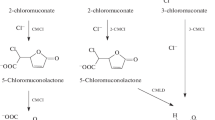Abstract
Of the four investigated Rhodococcus strains (R. rhodochrous172, R. opacus 4a and 557, and R. rhodnii 135), the first three strains were found to be able to completely transform fluorene when it was present in the medium as the sole source of carbon at a concentration of 12–25 mg/l. At a fluorene concentration of 50–100 mg/l in the medium, the rhodococci transformed 50% of the substrate in 14 days. The addition of casamino acids and sucrose (1–5 g/l) stimulated fluorene transformation, so that R. rhodochrous 172 could completely transform it in 2–5 days. Nine intermediates of fluorene transformation were isolated, purified, and structurally characterized. It was found that R. rhodnii 135 and R. opacus strains 4a and 557 hydroxylated fluorene with the formation of 2-hydroxyfluorene and 2,7-dihydroxyfluorene. R. rhodochrous 172 transformed fluorene via two independent pathways to a greater degree than the other rhodococci studied.
Similar content being viewed by others
REFERENCES
Grifoll, M., Gasellas, M., Bayona, J., and Solanas, A.M., Isolation and Characterization of a Fluorene-degrading Bacterium: Identification of Ring Oxidation and Ring Fission Products, Appl. Environ. Microbiol., 1992, vol. 58,no. 9, pp. 2910-2917.
Grifoll, M., Selifonov, S.A., Gatlin, C.V., and Chapman, P.J., Action of Versatile Fluorene-degrading Bacterial Isolate on Polycyclic Aromatic Compounds, Appl. Environ. Microbiol., 1995, vol. 61,no. 10, pp. 3711-3723.
Samanta, S.K., Chakraborti, A.K., and Jain, R.K., Degradation of Phenanthrene by Different Bacteria: Evidence for Novel Transformation Sequences Involving the Formation of 1-Naphthol, Appl. Microbiol. Biotechnol., 1999, vol. 53,no. 1, pp. 98-107.
Stringfellow, W. and Aitren, M.D., Competitive Metabolism of Naphthalene, Methylnaphthalenes, and Fluorene by Phenanthrene-degrading Pseudomonas, Appl. Environ. Microbiol., 1995, vol. 61,no. 1, pp. 357-362.
Gasellas, M., Grifoll, M., Sebate, J., and Solanas, A.M., Isolation and Characterization of a Fluorenone-degrading Bacterial Strain and Its Role in Synergistic Degradation of Fluorene by a Consortium, Can. J. Microbiol., 1998, vol. 44, pp. 734-742.
Grifoll, M., Selifonov, S.A., and Chapman, P.J., Evidence for a Novel Pathway in the Degradation of Fluorene by Pseudomonas sp. Strain F274, Appl. Environ. Microbiol., 1994, vol. 60,no. 7, pp. 2438-2449.
Monna, L., Omori, T., and Kodama, T., Microbial Degradation of Dibenzofuran, Fluorene, and Dibenzo-p-Dioxin by Staphylococcus auriculans DBF63, Appl. Environ. Microbiol., 1993, vol. 59,no. 1, p. 285.
Boldrin, B., Tiehm, A., and Fritzsche, C., Degradation of Phenanthrene, Fluorene, Fluoranthene and Pyrene by Mycobacterium sp. Appl. Environ. Microbiol., 1993, vol. 59,no. 6, pp. 1927-1930.
Gasellas, M., Grifoll, M., Bayona, J., and Solanas, A.M., New Metabolites in the Degradation of Fluorene by Arthrobacter sp. Strain F101, Appl. Environ. Microbiol., 1997, vol. 63,no. 3, pp. 819-826.
Kastner, M., Breuer-Jammali, M., and Mahro, B., Enumeration and Characterization of Soil Microflora from Hydrocarbon-contaminated Soil Sites Able to Mineralize Polycyclic Aromatic Hydrocarbons (PAH), Appl. Microbiol. Biotechnol., 1994, vol. 41, pp. 267-273.
Surovtseva, E.G., Ivoilov, V.S., and Belyaev, S.S., Degradation of the Aromatic Fraction of Oil by an Association of Gram-Positive and Gram-Negative Bacteria, Mikrobiologiya, 1997, vol. 66,no. 1, pp. 78-83.
Yamada, K., Horiguchi, S., and Takahashi, J., Studies on the Utilization of Hydrocarbons by Microorganisms, Agric. Biol. Chem., 1965, vol. 29,no. 10, pp. 943-948.
Baboshin, M.A., Finkelstein, Z.I., and Golovleva, L.A., Fluorene Cometabolism by Rhodococcus rhodochrous and Pseudomonas fluorescens Cultures, Mikrobiologiya, 2003, vol. 72,no. 2, pp. 194-198.
Yang, Y., Chen, R.F., and Shiaris, M.P., Metabolism of Naphthalene, Fluorene, and Phenanthrene: Preliminary Characterization of a Cloned Gene Cluster from Pseudomonas putida NCIB 9816, J. Bacteriol., 1994, vol. 176,no. 8, pp. 2158-2154.
Author information
Authors and Affiliations
Rights and permissions
About this article
Cite this article
Finkelstein, Z.I., Baskunov, B.P., Golovlev, E.L. et al. Fluorene Transformation by Bacteria of the Genus Rhodococcus . Microbiology 72, 660–665 (2003). https://doi.org/10.1023/B:MICI.0000008365.53111.a4
Issue Date:
DOI: https://doi.org/10.1023/B:MICI.0000008365.53111.a4




